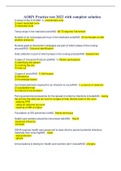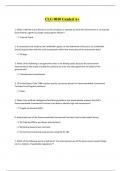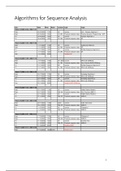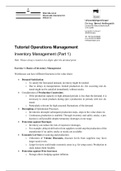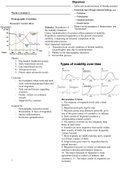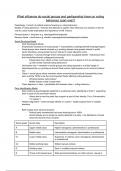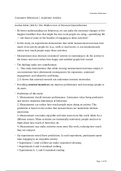!CONTENT ANALYSIS!
READING WEEK 1:
Chapter 1 (Introduction):
● Quantitative content analysis: the systematic assignment of communication content to
categories according to rules, and the analysis of relationships involving those categories
using statistical methods
● Empirical approach, scientific method (uses empirical cycle)
● Reductionist (believes that understanding comes through reducing a phenomenon to
smaller, more basic, individual parts (media, news, entertainment institutions →
individual communication messages or message aspects)
● Powerful media effects commonly assumed in early 20th century (hypodermic needle or
bullet)
○ Which made analysis of communication content important to study because it was
believed to have an effect
● Then, a limited effects perspective was explored
○ Bc in the real world, people can choose what media and what parts of messages
they look at and take in
● Now? Contingency effects perspective: effects - powerful or limited - of mass media are
contingent on a variety of factors and conditions
● Frame: “central organizing idea for news content that supplies a context and suggests
what the issue is through the use of selection, emphasis, exclusion, and elaboration”
● Content as a consequence of something (rather than causing
effects):
○ Content can be a result of, e.g. news values or the
context it was created in
○ Analyzing content post production is nice because
it’s unobtrusive/non-reactive evidence. The act of
measuring or analyzing the content won’t affect the
content itself because of, for example, the
communicator being self-conscious or reactive to
being observed, because the measurements are
happening after the content is produced
● Therefore, centrality model of communication content —→
● Description as a goal of research (rather than
understanding/theory-building):
1
, ○ Can act as ‘reality checks’ or highlight media distortion
○ Or a first phase research program
● Content analysis can be used with other research strategies (to find effects or make
applications to real life (theory-derived hypotheses))
● Use of coding has made it easier to do content analysis on huge populations
○ Limitations: may be too broad? Gives only a bird’s eye perspective
○ Vulnerable to flaws in the coding
Chapter 2 (Content Analysis as a Social Science Tool)
● Content analysis purpose + procedure based on social science approach to knowledge:
○ System of standards and guidelines for generating relational statements that
describe and explain human behaviors and mental processes
○ Science provides:
■ 1. Method of organizing and categorizing things (typology)
■ 2. Predictions of future events
■ 3. Explanations of past events
■ 4. Sense of understanding about what causes events
■ 5. Potentially the control of events
○ Goal of scientific proccess: theory-building and testing
○ Science is:
■ Abstract
● Concept is independent of a particular time and place
■ Intersubjective
● Requires that scientists who study an area agree on what a concept
means and also on the validity of relationships among the concepts
● And agreement about the use of a specific system for developing a
theory (e.g. use of language reasoning or mathematics)
■ empirically relevant
● Ability to compare theoretical statements with objective empirical
data
● The textbook’s definition of quantitative content analysis: systematic and replicable
examination of symbols of communication, which have been assigned numeric values
according to valid measurement rules, and the analysis of relationships involving those
values using statistical methods, to describe the communication, draw inferences about its
meaning, or infer from the communication to its context, both of production and
consumption
○ Systematic: identification of key terms or concepts involved in a phenomenon,
specification of possible relationships among concepts, and generation of testable
hypotheses
2
, ○ Replicability entails operationalization (defining concepts in terms of the actual,
measured variables)
○ Symbols of communication: verbal, textual, or images
○ Describing and inferring:
■ Content analyses can be descriptive or
■ Descriptive data can be used to infer about meaning or infer from the
communication to its context (production and consumption)
● The “why?”
● guided by theory
● Possible limitations of content analysis as a research technique
○ Too much emphasis on comparative frequency of different symbols’ appearance
○ Quantification leads to trivialization: problems are selected for research simply
because they are quantifiable, at the cost of problem significance
■ But, trivialization is due to the researcher not the technique of content
analysis itself
○ With computational/automated coding, content analyses may ignore the context of
specific communication symbols
○ Coding can be subjective
● Advantages of quantitative content analysis of manifest content
○ Unobtrusive, non-reactive measurement technique
○ Longitudinal studies are possible using archived materials that may outlive the
communicators, their audiences, or the events described in the communication
content
○ Quantification or measurement by coding teams using a well-developed protocol
permits reduction to numbers of large amounts of information or numbers of
messages that would be logistically impossible to understand well with close
qualitative analysis.
○ Applicable to a variety of questions in many disciplines and fields because
communication is central in human affairs
○ reliability/consistency of coding can be measured
● When to use content analysis?
○ 1. Data accessibility is a problem and the investigator is limited to using
documentary evidence
○ 2. Communicator’s ‘own language’ use and structure is critical
○ 3. Volume of material exceeds the investigator’s individual capability to examine
it
Chapter 8 (Designing a Content Analysis):
● Process of learning about a phenomenon empirically in order to study them consists of
three stages:
○ 1. Conceptualization of the inquiry
3
, ○ 2. Formulation of a research design to gather needed information
○ 3. Data collection and analysis to get answers
●
○ ^ phase 1 → phase 2
● Three types of content studies:
○ 1. Studies that use content analysis only
■ Looks at variable(s) across time
■ OR assess factors observable through content analysis for their influence
on some particular content variable
● E.g. looking at agendas on news media and comparing with
agendas on social media
○ 2. Studies that use content analysis with other methods to explore influences on
content
○ 3. Studies that use content analysis in conjunction with other methods to explore
content effects
● Explicit hypothesis or research question is necessary to guide design
○ Also lack of hypothesis/rq encourages hunt for any statistically significant
associations which may be spurious
● Three conditions for causal relationship:
○ Time order (cause should precede effect)
○ Observable correlation between the IV and DV
○ Exclusion of confounding/other variables
● A good research design:
○ makes explicit and integrates procedures for selecting a sample of data for
analysis, content categories and units to be placed into the categories,
4
READING WEEK 1:
Chapter 1 (Introduction):
● Quantitative content analysis: the systematic assignment of communication content to
categories according to rules, and the analysis of relationships involving those categories
using statistical methods
● Empirical approach, scientific method (uses empirical cycle)
● Reductionist (believes that understanding comes through reducing a phenomenon to
smaller, more basic, individual parts (media, news, entertainment institutions →
individual communication messages or message aspects)
● Powerful media effects commonly assumed in early 20th century (hypodermic needle or
bullet)
○ Which made analysis of communication content important to study because it was
believed to have an effect
● Then, a limited effects perspective was explored
○ Bc in the real world, people can choose what media and what parts of messages
they look at and take in
● Now? Contingency effects perspective: effects - powerful or limited - of mass media are
contingent on a variety of factors and conditions
● Frame: “central organizing idea for news content that supplies a context and suggests
what the issue is through the use of selection, emphasis, exclusion, and elaboration”
● Content as a consequence of something (rather than causing
effects):
○ Content can be a result of, e.g. news values or the
context it was created in
○ Analyzing content post production is nice because
it’s unobtrusive/non-reactive evidence. The act of
measuring or analyzing the content won’t affect the
content itself because of, for example, the
communicator being self-conscious or reactive to
being observed, because the measurements are
happening after the content is produced
● Therefore, centrality model of communication content —→
● Description as a goal of research (rather than
understanding/theory-building):
1
, ○ Can act as ‘reality checks’ or highlight media distortion
○ Or a first phase research program
● Content analysis can be used with other research strategies (to find effects or make
applications to real life (theory-derived hypotheses))
● Use of coding has made it easier to do content analysis on huge populations
○ Limitations: may be too broad? Gives only a bird’s eye perspective
○ Vulnerable to flaws in the coding
Chapter 2 (Content Analysis as a Social Science Tool)
● Content analysis purpose + procedure based on social science approach to knowledge:
○ System of standards and guidelines for generating relational statements that
describe and explain human behaviors and mental processes
○ Science provides:
■ 1. Method of organizing and categorizing things (typology)
■ 2. Predictions of future events
■ 3. Explanations of past events
■ 4. Sense of understanding about what causes events
■ 5. Potentially the control of events
○ Goal of scientific proccess: theory-building and testing
○ Science is:
■ Abstract
● Concept is independent of a particular time and place
■ Intersubjective
● Requires that scientists who study an area agree on what a concept
means and also on the validity of relationships among the concepts
● And agreement about the use of a specific system for developing a
theory (e.g. use of language reasoning or mathematics)
■ empirically relevant
● Ability to compare theoretical statements with objective empirical
data
● The textbook’s definition of quantitative content analysis: systematic and replicable
examination of symbols of communication, which have been assigned numeric values
according to valid measurement rules, and the analysis of relationships involving those
values using statistical methods, to describe the communication, draw inferences about its
meaning, or infer from the communication to its context, both of production and
consumption
○ Systematic: identification of key terms or concepts involved in a phenomenon,
specification of possible relationships among concepts, and generation of testable
hypotheses
2
, ○ Replicability entails operationalization (defining concepts in terms of the actual,
measured variables)
○ Symbols of communication: verbal, textual, or images
○ Describing and inferring:
■ Content analyses can be descriptive or
■ Descriptive data can be used to infer about meaning or infer from the
communication to its context (production and consumption)
● The “why?”
● guided by theory
● Possible limitations of content analysis as a research technique
○ Too much emphasis on comparative frequency of different symbols’ appearance
○ Quantification leads to trivialization: problems are selected for research simply
because they are quantifiable, at the cost of problem significance
■ But, trivialization is due to the researcher not the technique of content
analysis itself
○ With computational/automated coding, content analyses may ignore the context of
specific communication symbols
○ Coding can be subjective
● Advantages of quantitative content analysis of manifest content
○ Unobtrusive, non-reactive measurement technique
○ Longitudinal studies are possible using archived materials that may outlive the
communicators, their audiences, or the events described in the communication
content
○ Quantification or measurement by coding teams using a well-developed protocol
permits reduction to numbers of large amounts of information or numbers of
messages that would be logistically impossible to understand well with close
qualitative analysis.
○ Applicable to a variety of questions in many disciplines and fields because
communication is central in human affairs
○ reliability/consistency of coding can be measured
● When to use content analysis?
○ 1. Data accessibility is a problem and the investigator is limited to using
documentary evidence
○ 2. Communicator’s ‘own language’ use and structure is critical
○ 3. Volume of material exceeds the investigator’s individual capability to examine
it
Chapter 8 (Designing a Content Analysis):
● Process of learning about a phenomenon empirically in order to study them consists of
three stages:
○ 1. Conceptualization of the inquiry
3
, ○ 2. Formulation of a research design to gather needed information
○ 3. Data collection and analysis to get answers
●
○ ^ phase 1 → phase 2
● Three types of content studies:
○ 1. Studies that use content analysis only
■ Looks at variable(s) across time
■ OR assess factors observable through content analysis for their influence
on some particular content variable
● E.g. looking at agendas on news media and comparing with
agendas on social media
○ 2. Studies that use content analysis with other methods to explore influences on
content
○ 3. Studies that use content analysis in conjunction with other methods to explore
content effects
● Explicit hypothesis or research question is necessary to guide design
○ Also lack of hypothesis/rq encourages hunt for any statistically significant
associations which may be spurious
● Three conditions for causal relationship:
○ Time order (cause should precede effect)
○ Observable correlation between the IV and DV
○ Exclusion of confounding/other variables
● A good research design:
○ makes explicit and integrates procedures for selecting a sample of data for
analysis, content categories and units to be placed into the categories,
4


